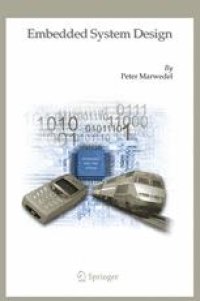
Ebook: Embedded System Design
Author: Peter Marwedel (auth.)
- Tags: Electronic and Computer Engineering, Computer-Aided Engineering (CAD CAE) and Design, Circuits and Systems, Computer Science general
- Year: 2006
- Publisher: Springer US
- Language: English
- pdf
Until the late eighties, information processing was associated with large mainframe computers and huge tape drives. During the nineties, this trend shifted towards information processing with personal computers, or PCs. The trend towards miniaturization continues. In the future, most of the information processing systems will be quite small and embedded into larger products such as transportation and fabrication equipment. Hence, these kinds of systems are called embedded systems. It is expected that the total market volume of embedded systems will be significantly larger than that of traditional information processing systems such as PCs and mainframes. Embedded systems share a number of common characteristics. For example, they must be dependable, efficient, meet real-time constraints and require customized user interfaces (instead of generic keyboard and mouse interfaces). Therefore, it makes sense to consider common principles of embedded system design.
Embedded System Design starts with an introduction into the area and a survey of specification languages for embedded systems. A brief overview is provided of hardware devices used for embedded systems and also presents the essentials of software design for embedded systems. Real-time operating systems and real-time scheduling are covered briefly. Techniques for implementing embedded systems are also discussed, using hardware/software codesign. It closes with a survey on validation techniques.
Embedded System Design can be used as a text book for courses on embedded systems and as a source which provides pointers to relevant material in the area for PhD students and teachers. The book assumes a basic knowledge of information processing hardware and software.
Until the late eighties, information processing was associated with large mainframe computers and huge tape drives. During the nineties, this trend shifted towards information processing with personal computers, or PCs. The trend towards miniaturization continues. In the future, most of the information processing systems will be quite small and embedded into larger products such as transportation and fabrication equipment. Hence, these kinds of systems are called embedded systems. It is expected that the total market volume of embedded systems will be significantly larger than that of traditional information processing systems such as PCs and mainframes. Embedded systems share a number of common characteristics. For example, they must be dependable, efficient, meet real-time constraints and require customized user interfaces (instead of generic keyboard and mouse interfaces). Therefore, it makes sense to consider common principles of embedded system design.
Embedded System Design starts with an introduction into the area and a survey of specification languages for embedded systems. A brief overview is provided of hardware devices used for embedded systems and also presents the essentials of software design for embedded systems. Real-time operating systems and real-time scheduling are covered briefly. Techniques for implementing embedded systems are also discussed, using hardware/software codesign. It closes with a survey on validation techniques.
Embedded System Design can be used as a text book for courses on embedded systems and as a source which provides pointers to relevant material in the area for PhD students and teachers. The book assumes a basic knowledge of information processing hardware and software.
Content:
Front Matter....Pages i-xvii
Introduction....Pages 1-11
Specifications....Pages 13-85
Embedded System Hardware....Pages 87-123
Standard Software: Embedded Operating Systems, Middleware, and Scheduling....Pages 125-150
Implementing Embedded Systems: Hardware/Software Codesign....Pages 151-197
Validation....Pages 199-211
Back Matter....Pages 212-241
Until the late eighties, information processing was associated with large mainframe computers and huge tape drives. During the nineties, this trend shifted towards information processing with personal computers, or PCs. The trend towards miniaturization continues. In the future, most of the information processing systems will be quite small and embedded into larger products such as transportation and fabrication equipment. Hence, these kinds of systems are called embedded systems. It is expected that the total market volume of embedded systems will be significantly larger than that of traditional information processing systems such as PCs and mainframes. Embedded systems share a number of common characteristics. For example, they must be dependable, efficient, meet real-time constraints and require customized user interfaces (instead of generic keyboard and mouse interfaces). Therefore, it makes sense to consider common principles of embedded system design.
Embedded System Design starts with an introduction into the area and a survey of specification languages for embedded systems. A brief overview is provided of hardware devices used for embedded systems and also presents the essentials of software design for embedded systems. Real-time operating systems and real-time scheduling are covered briefly. Techniques for implementing embedded systems are also discussed, using hardware/software codesign. It closes with a survey on validation techniques.
Embedded System Design can be used as a text book for courses on embedded systems and as a source which provides pointers to relevant material in the area for PhD students and teachers. The book assumes a basic knowledge of information processing hardware and software.
Content:
Front Matter....Pages i-xvii
Introduction....Pages 1-11
Specifications....Pages 13-85
Embedded System Hardware....Pages 87-123
Standard Software: Embedded Operating Systems, Middleware, and Scheduling....Pages 125-150
Implementing Embedded Systems: Hardware/Software Codesign....Pages 151-197
Validation....Pages 199-211
Back Matter....Pages 212-241
....